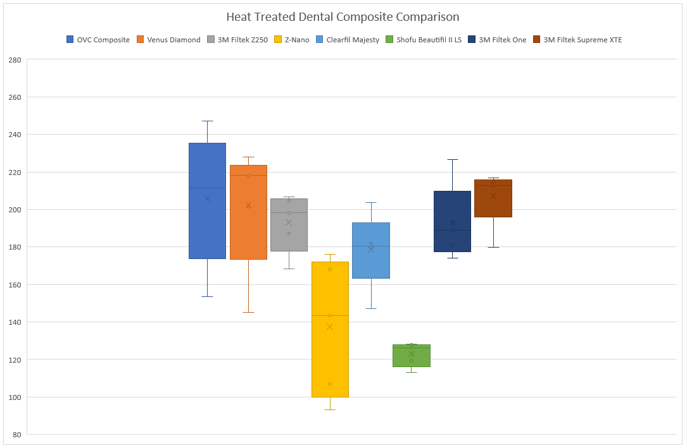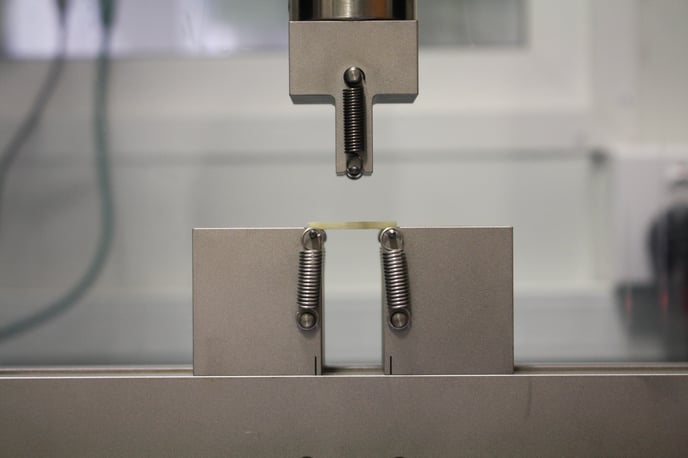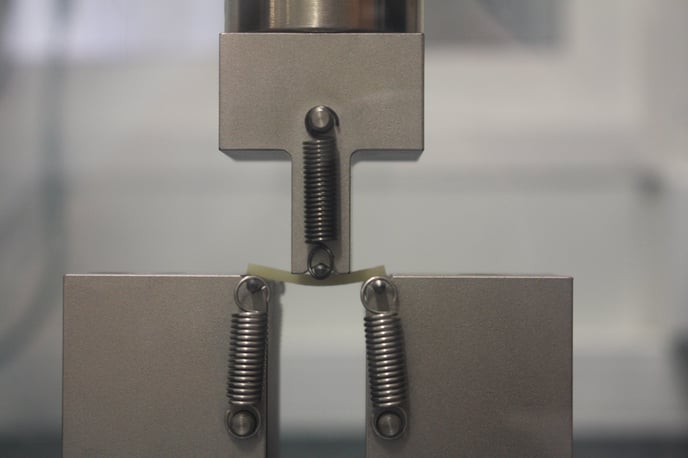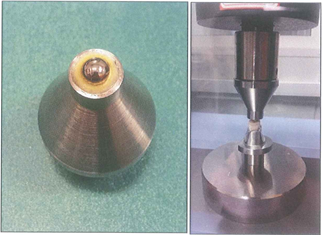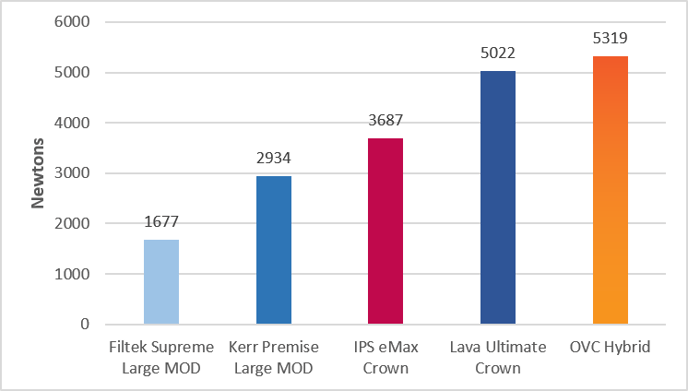How Can We Help?
How strong is the One Visit Crown material?
How strong is the OVC material? What is the OVC material exactly? What are the OVC material characteristics?
What is the OVC material?
OVC material is a light-cured resin composite formulated with 73% zirconia filled particles ranging in size from micro-sized to larger particles to help give it characteristics similar to dentine. OVC material is a hybrid ceramic composite (heavily filled dental composite).
OVC Material Flexural Strengths
The OVC is composed of two layers – both layers are the same material.
Fig. 1 – OVC Crown design concept showing heat-treated vs un-cured layer
The heat-treated occlusal layer on top of the OVC showed flexural strengths of up to 214 MPa.
The un-cured OVC material in the under-layer showed flexural strengths of 146 MPa when cured with a conventional dental curing light.
Testing Method (internal testing)
The flexural strength test was performed as per ISO 6872, Section 7.3.3 for Type II Ceramics and protocol RHTP0074 Biaxial Flexural Strength Testing, with the following points of note:
– 15mm test disks will be made from several different composites
– Samples will then be light-cured in the ProCure Light Oven for 2 minutes.
– Samples will then be heat treated at 110°C for 15 min.
– Samples are then tested in the universal tester with the three-point equi-biaxial test apparatus.
– LDPE thin films (70µm thickness) were used between specimens and supporting balls/loading piston of the bi-axial testing apparatus.
OVC Material Flex
OVC material bends significantly in flexural strength bar tests before breaking vs. ceramic materials. This gives OVC restorations a cushioning effect to mimic a patient’s normal dentine.
Fig. 2 – Rhondium dental labs flexural strength testing apparatus
Fig. 3 – Rhondium dental labs flexural strength testing apparatus showing the flex of OVC material before failure.
When testing OVC restorations on human teeth to destruction we found very high compressive load forces before failure compared to more brittle ceramic restorations. This can be explained by the flex of the OVC material.
Compressive Strength Testing to Failure
OVC crowns have been subjected to destructive load testing (in-house testing). Extracted human lower right molar teeth were used in this study. The following restorations were compared, and five teeth were in each group:
| Restoration System Tested |
| Filtek Supreme Large MOD |
| Premise Large MOD |
| OVC Hybrid |
| IPS e.max crown (CAD/CAM) |
| Lava Ultimate crown (CAD/CAM) |
The crowns were bonded to the tooth with Multilink (Ivoclar) and the MOD restorations were bonded with Optibond FL (Kerr).
A tungsten carbide spherical ball was used in a load testing machine until the restoration fractured.
Fig. 4. Fracture resistance graph – average maximum load at failure
Note that both the Lava Ultimate and the OVC Hybrid withstood more than half a metric ton before they disintegrated.
The OVC Hybrid withstood a 44% higher load than the e.max crowns and more than double that of the MOD restorations.
Typically, at the maximum load (average 5319N), the entire OVC Hybrid crown/tooth complex gave way.
Fig 7. A typical example of OVC Hybrid crown at maximum load
In contrast, the e.max crowns tended to fracture at maximum load (average 3687N) as shown below:
Fig 8. A typical example of eMax crown at maximum load
Note: that the maximum loads that humans can apply to teeth is around 600N for females and up to 850N for males but can be higher when individuals unintentionally bite hard on say, a stone in food (Waltimo A, 1193).
Fig. 9 Graph showing compressive load force to destruction in Newtons
How long will OVC restorations last? What can you confidently tell your patients?
References:
Waltimo A, K. M. (1193). A novel bite force recorder and maximal isometric bite force values for healthy young adults. Scan J Dent Res, 101:171-175.
Disclaimer: This document contains a survey of internal and external scientific data (“Information”). The documentation and information have been prepared exclusively for use in-house by Rhondium and for external Rhondium partners. They are not intended to be used for any other purpose. While we believe the Information is current, we have not reviewed all of the Information, and we cannot and do not guarantee its accuracy, truthfulness, or reliability. We will not be liable for use of or reliance on any of the Information, even if we have been advised to the contrary. In particular, use of the Information is at your sole risk. It is provided “as-is”, “as available” and without any warranty express or implied, including (without limitation) of product merchantability or fitness for a particular purpose. The Information has been provided without cost to you and in no event will we or anyone associated with us be liable to you or any other person for any incidental, direct, indirect, consequential, special, or punitive damages (including, but not limited to, loss of profits, damages for lost data, loss of use, or any cost to procure substitute information) arising out of your or another’s use of or inability to use the Information even if we or our agents know of the possibility of such damages.


